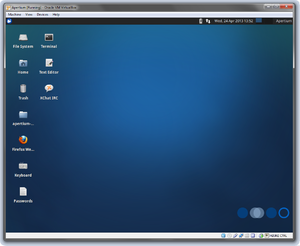Difference between revisions of "Apertium VirtualBox"
(Updated to Xubuntu 13.10) |
|||
| Line 30: | Line 30: | ||
On first boot, it looks like: |
On first boot, it looks like: |
||
http://tinodidriksen.com/uploads/Apertium-VirtualBox.png |
http://tinodidriksen.com/uploads/Apertium-VirtualBox-20131103.png |
||
On the desktop is apertium-kaz-tat which works - compiling and testing that language pair should pretty much guarantee all required tools are installed and functional. |
On the desktop is apertium-kaz-tat which works - compiling and testing that language pair should pretty much guarantee all required tools are installed and functional. |
||
| Line 56: | Line 56: | ||
5. For Memory, give it at least 512 MB RAM - it might run with less, but the more the better. |
5. For Memory, give it at least 512 MB RAM - it might run with less, but the more the better. |
||
6. For Hard Disk, select the "Use an existing virtual hard drive file" radio button. Pick Apertium (Xubuntu |
6. For Hard Disk, select the "Use an existing virtual hard drive file" radio button. Pick Apertium (Xubuntu 13.10).vdi from the drop-down menu, or if it isn't there, click the folder icon with the green arrow to the right and navigate to wherever you unzipped the file to. Finish the process by clicking "Create". |
||
7. You can now run the new virtual box. On first boot it should look like this: http://tinodidriksen.com/uploads/Apertium-VirtualBox.png |
7. You can now run the new virtual box. On first boot it should look like this: http://tinodidriksen.com/uploads/Apertium-VirtualBox-20131103.png |
||
Revision as of 21:21, 3 November 2013
Since so many have problems getting Apertium to run on Windows or OS X, or are limited in bandwidth, Tino Didriksen has put together a ready-to-use VirtualBox VDI:
http://tinodidriksen.com/uploads/Apertium-VirtualBox-20131103.7z
570053064 bytes (544 MB - still smaller than an Ubuntu ISO !) SHA-1: 93e05a9785d5ef16a292ada37ba02a2e45c1ac08 MD5: 605047a120f298403990f54fba371746
The archive decompresses to a 4 GB vdi file.
Contents
- Xubuntu 13.10, so Xfce4 instead of Unity (Ubuntu's fancy-yet-useless interface), trimmed of all non-essential packages
- VirtualBox 4.3.0 Guest Additions
- XChat, set to automatically connect to Freenode #apertium as nick ap-vbox (appending -2 or -3 on conflict), preconfigured in UTF-8 mode
- Firefox, homepage set to Apertium Wiki
- Gedit
- Foma 0.17
- HFST 3.5.0
- CG-3
- Apertium
- lttoolbox
- apertium-lex-tools
It automatically logs in to a 1024x768 desktop. All passwords set to 'apertium' for when root is needed. Keyboard and timezone are set to Danish, but there is a shortcut for Keyboard configuration on the desktop.
On first boot, it looks like:
http://tinodidriksen.com/uploads/Apertium-VirtualBox-20131103.png
On the desktop is apertium-kaz-tat which works - compiling and testing that language pair should pretty much guarantee all required tools are installed and functional.
Nothing else from svn is left checked out - all was wiped after installing in order to save space.
The image is set up as a dynamically expanding hdd with max size 64 GB, where 8 GB is allocated to swap space.
To install you will need:
- VirtualBox from http://virtualbox.org/
- 7-Zip from http://7-zip.org/ or something else that can decompress 7z files
Step-by-Step Installation Instructions
1. Download the file (http://tinodidriksen.com/uploads/Apertium-VirtualBox-20131103.7z).
2. Use 7-Zip or a similar program to unzip the file. There should be exactly one thing in the unzipped folder - the Virtual Disk Image (VDI) entitled Apertium (Xubuntu 13.10).
3. Start VirtualBox and click "New" to create a new virtual machine.
4. For the OS Type, select Linux, Ubuntu.
5. For Memory, give it at least 512 MB RAM - it might run with less, but the more the better.
6. For Hard Disk, select the "Use an existing virtual hard drive file" radio button. Pick Apertium (Xubuntu 13.10).vdi from the drop-down menu, or if it isn't there, click the folder icon with the green arrow to the right and navigate to wherever you unzipped the file to. Finish the process by clicking "Create".
7. You can now run the new virtual box. On first boot it should look like this: http://tinodidriksen.com/uploads/Apertium-VirtualBox-20131103.png
